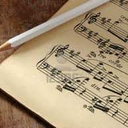"Горько, горько мне, красной девице..." — М. И. Глинка | Играет Андрей Киселев
Фортепианное исполнение романса Михаила Ивановича Глинки "Горько, горько мне, красной девице..." на слова Александра Яковлевича Римского-Корсака
Горько, горько мне,
Красной девице
В светлом тереме,
В злате-серебре.
Ах, подруженьки,
Вы не пойте мне
Песни брачные.
Ах, подруженьки,
Песни брачные
Вы не пойте мне.
Песни брачные
Нарозь сердце рвут,
Нарозь сердце рвут.
Вы запойте мне
Песню горькую,
Погребальную.
Страшно в поле
В ночь осеннюю,
Страшно на поле
В ночь осеннюю,
Когда солнышко,
Когда красное
За лес прячется,
Когда солнышко,
Когда красное
За лес прячется.
Грустно, милые,
Без услада мне,
Без услада мне,
Как без солнышка
Полевым цветам,
Без услада мне.
Сборник нот - Бесконечное Лето
Дорогие друзья! Мы рады сообщить вам о запуске нашего нового проекта, посвященного музыкальному сопровождению визуальной новеллы "Бесконечное Лето". В нашем Телеграм-канале вы сможете бесплатно получить ноты и MIDI-файлы для фортепиано, которые помогут вам погрузиться в атмосферу этой замечательной истории.
Зачем играть музыку из "Бесконечного Лета"?
"Бесконечное Лето" стало культовым произведением, которое оставило глубокий след в сердцах многих поклонников. Его музыка наполнена эмоциями и прекрасно передает настроение лета, дружбы и ностальгии. Играя мелодии из этой визуальной новеллы, вы не только сможете улучшить свои навыки игры на фортепиано, но и насладиться музыкой, которая вызывает теплые воспоминания.
Что мы предлагаем?
• Бесплатные ноты: Мы предлагаем удобные и понятные ноты для фортепиано, которые подойдут как для начинающих, так и для более опытных музыкантов. Каждая партия сопровождается подробными указаниями, чтобы вы могли легко освоить игру.
• MIDI-файлы: Для тех, кто предпочитает цифровые форматы, мы предоставляем MIDI-файлы. Они идеально подходят для практики, а также могут быть использованы для создания собственных аранжировок или композиций.
• Обновления и новые композиции: Мы регулярно обновляем наш контент, добавляя новые произведения из "Бесконечного Лета". Подписавшись на наш канал, вы всегда будете в курсе последних новинок.
Как присоединиться к нашему каналу?
Чтобы получить доступ к бесплатным нотам и MIDI-файлам, просто присоединитесь к нашему Telegram-каналу. Мы стараемся обновлять контент регулярно, так что вы всегда сможете найти что-то новое и интересное.
Почему это важно?
Музыка — это не только способ самовыражения, но и отличный способ расслабиться и отвлечься от повседневной суеты. Играя на фортепиано, вы развиваете свои творческие способности, улучшаете концентрацию и получаете удовольствие от процесса. Ноты и MIDI-файлы из "Бесконечного Лета" помогут вам сделать этот процесс еще более увлекательным.
Заключение
Не упустите возможность насладиться музыкой "Бесконечного Лета" и развить свои навыки игры на фортепиано. Присоединяйтесь к нашему Телеграм-каналу, делитесь своими успехами и находите единомышленников. Мы уверены, что этот проект станет отличным дополнением к вашему музыкальному опыту!
К Музыке (An die Musik, D.547) — Ф. Шуберт | Играет Андрей Киселев
Фортепианное исполнение песни "К Музыке" (An die Musik, D.547) Франца Шуберта (Franz Schubert) на слова Франца фон Шобера (Franz von Schober)
Du holde Kunst, in wieviel grauen Stunden,
Wo mich des Lebens wilder Kreis umstrickt,
Hast du mein Herz zu warmer Lieb' entzunden,
Hast mich in eine beßre Welt entrückt,
In eine beßre Welt entrückt!
(Бесценный дар! Как часто в дни печали
Ты, исцеляя боль сердечных мук,
Уносишь мысль в заоблачные дали,
Лишь твой заслышу сердцу милый звук,
Лишь твой заслышу волшебный звук.)
Oft hat ein Seufzer, deiner Harf' entflossen,
Ein süßer, heiliger Akkord von dir,
Den Himmel beßrer Zeiten mir erschlossen,
Du holde Kunst, ich danke dir dafür,
Du holde Kunst, ich danke dir!
(И, часто внемля вздохам арфы нежной,
Я, восхищенный, в облаках парю.
За этот дар, за этот дар бесценный,
О, музыка, тебя благодарю,
За этот дар благодарю!)
Почти Орган
Токката и фуга ре минор (BWV 565) — произведение для органа Иоганна Себастьяна Баха, одно из наиболее популярных его сочинений.
Произведение предположительно написано Бахом во время его пребывания в Арнштадте в период между 1703 и 1707 годами.
Токката начинается ярко выделяющимся мордентом, который повторяется октавой ниже. Она состоит из контрастных по темпу и фактуре эпизодов, оканчивающихся каденциями. Начинаясь с allegro, токката заканчивается в темпе adagio на третьей ступени ре минора (фа), что добавляет незавершённость и даёт понять, что это ещё не финал.
"«Я люблю», — ты мне твердила..." — М. И. Глинка | Играет Андрей Киселев
Фортепианное исполнение романса Михаила Ивановича Глинки "«Я люблю», — ты мне твердила..." на слова Александра Яковлевича Римского-Корсака
«Я люблю», — ты мне твердила,
И тебе поверил я.
Но другого ты любила,
Мне так страстно говоря:
«Я люблю, я люблю», —
Мне так страстно говоря.
Ты зачем таким признаньем
Взволновала грудь мою!
С тяжким слышал я терзаньем:
«Друг! Я милого люблю,
Я люблю, я люблю,
Друг! Я милого люблю!»
Ах! Кого полюбишь страстно,
Горько той лишь другом быть.
Об одном молю, несчастный,
Перестань мне говорить:
«Я люблю, я люблю,
Друг! Я милого люблю!»
“The ‘Max’s Wheel’ Tuning Wrench: Enhanced Precision and Ergonomics in Piano Tuning, with a Case Study of Pinless Mason & Hamlin Models”
This paper explores the limitations of traditional T-bar tuning wrenches,
specifically those used in pinless Mason & Hamlin pianos, and introduces the
‘Max’s Wheel’ tuning wrench as a novel solution that enhances both
precision and ergonomics in piano tuning. Through comparative analysis and
engineering considerations, this study demonstrates the ‘Max’s Wheel’s’
advantages over traditional tools, particularly in systems lacking traditional
pinblocks and where direct impact force application is problematic.
1. Introduction
Piano tuning is a delicate task that demands precision and control.
Traditional T-bar tuning wrenches, while widely used, present limitations in
ergonomics and precision, especially in complex piano designs such as those
found in pinless Mason & Hamlin models. This paper will examine how the
traditional T-bar has led to many problems due to its straight line direct
impact. The aim is to introduce ‘Max’s Wheel’ a new innovative tool for piano
tuning and compare it to existing methods.
2. Challenges with Traditional T-Bar Tuning Wrenches
The T-bar tuning wrench is widely used for piano tuning. However, it
presents several challenges, particularly in Mason & Hamlin models:
Direct impact force: The application of direct linear force often leads
to uncontrolled movements, making accurate adjustments difficult and
also leads to breakage of the pin or the string.
Ergonomic concerns: The T-bar handle is difficult to grip, especially
during sustained use, often leading to fatigue for a piano tuner.
Limited control: The traditional T-bar doesn’t allow for fine
adjustment; they are designed for impact movements, not subtle
adjustments.
3. Design and Principles of the “Max’s Wheel” Tuning Wrench
The “Max’s Wheel” tuning wrench is a novel tool, developed to resolve the
shortcomings of the traditional T-bar, especially when used with more
complicated and precise instruments. Its main components are:
Handle: A steel rod with a rectangular cross-section (100 mm length,
15 mm x 5 mm) designed to attach a wheel.
Wheel: A standard plumbing valve wheel (50 mm diameter, metal)
that is connected to the handle using a standard right-hand thread.
Rubber Rim: A rubber rim fits snugly onto the outer edge of the
wheel.
This design has many advantages that traditional wrenches can’t provide:
Rotational Action: The wheel is used in a rotational manner
providing for fine tuning and gradual movement of pins without a
direct impact force. This provides for more precise tuning.
Ergonomic Improvement: The wheel and handle design allows a
more natural hand position. It allows a more comfortable grip and
reduces the fatigue associated with prolonged use.
Enhanced Control: The rotational action, instead of impact, offers
more controlled pin movement resulting in more accurate adjustments,
minimizing the possibility of over turning pins, and breaking strings.
4. Application to Pinless Mason & Hamlin Pianos
The pinless design of many Mason & Hamlin pianos creates unique tuning
challenges due to the absence of traditional pinblocks. In these instruments,
the tuning pins are directly mounted into a metal structure. This requires an
extremely precise movement that traditional T-bar methods can not provide.
The ‘Max’s Wheel’ provides the solution for these challenges:
Direct Mounting: The direct contact of the metal base allows no
cushion for direct impact, making a more difficult application with T-
bar methods.
Reduced risk of damage: Due to the use of rotation as a means of
tuning the pins, direct impact is avoided and eliminates unnecessary
forces that could damage the instrument.
More stable tuning: The precision rotation and reduction of
unnecessary forces allows the pins to be tuned and kept in tune for
longer periods.
5. Comparative Analysis
A comparative analysis of the T-bar tuning wrench versus the ‘Max’s Wheel’
highlights the advantages of the latter:
Feature Traditional T-Bar
‘Max’s Wheel’ Tuning
Wrench
Action
Direct impact force;
linear
Rotational motion; fine and
gradual
Precision
Limited, often
requiring multiple
attempts
High precision and easy to
dial in the exact pitch
Ergonomics
Difficult grip, leading
to fatigue
Enhanced grip, more
comfortable
Pin Protection
High risk of damage
due to direct impact
Minimized risk due to
rotation and no direct
impact
Suitability to
difficult systems
Inadequate for difficult
pinless systems
Designed for the most
challenging pin systems
6. Versatility in Traditional Pinblock Systems
While the ‘Max’s Wheel’ has been developed with the pinless system in
mind, it can also be used on more common wood pinblocks, with the added
benefits of increased control and lower risk of breakage due to its use of
rotational action, and a more comfortable and ergonomic design for tuners.
7. Conclusion
The ‘Max’s Wheel’ tuning wrench is a superior tool for piano tuning,
especially in complicated pinless systems. It offers significant improvements
in precision, ergonomics, and control compared to traditional T-bar tuning
wrenches. It also reduces the risks of damage to the pins, strings and other
parts of the instrument. The ‘Max’s Wheel’ can provide for more accurate
and stable tuning. Its design makes it an essential tool for the modern piano
tuner, and a superior tool for all systems from older wood pinblock designs to
modern pinless models.


